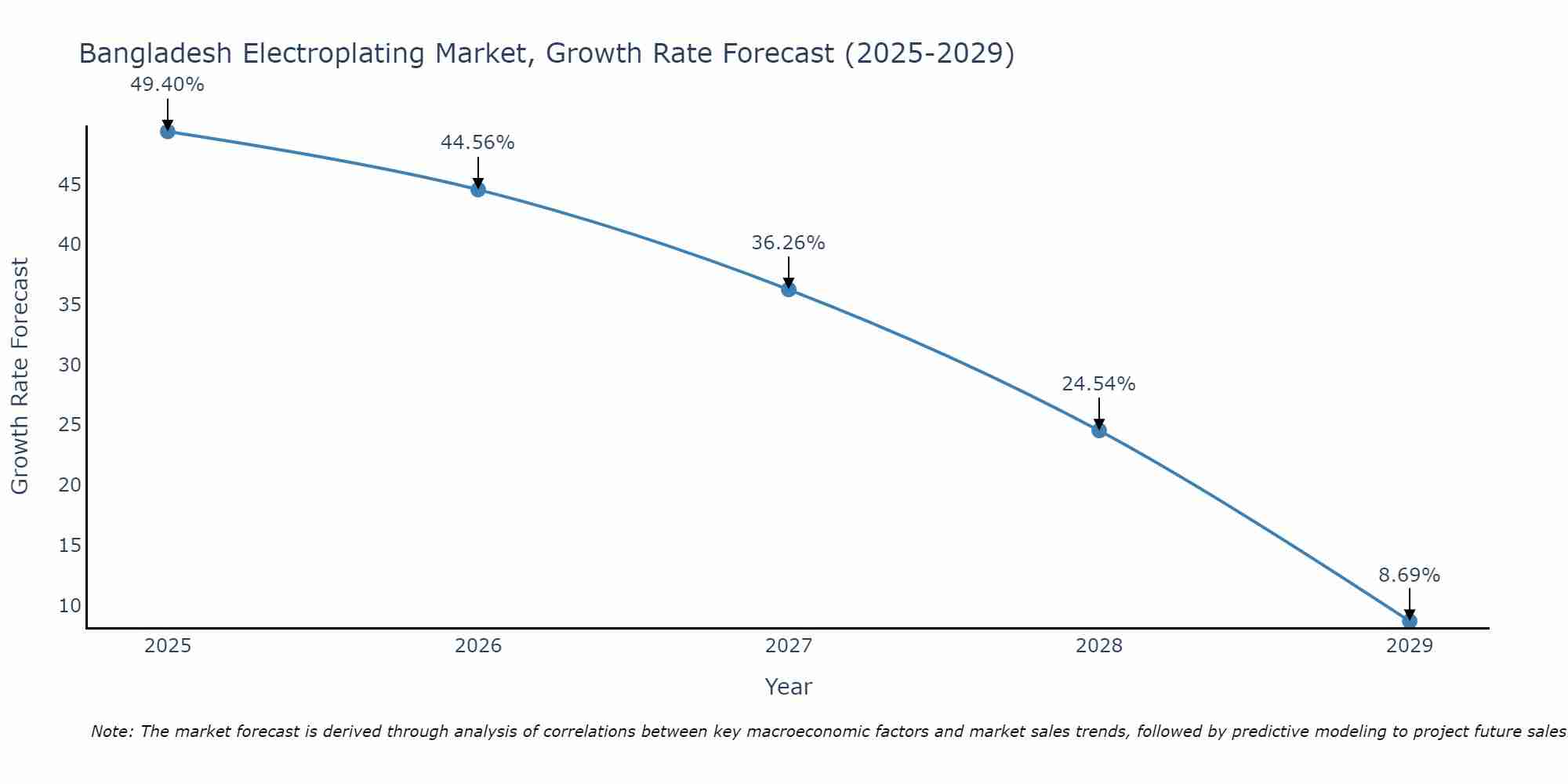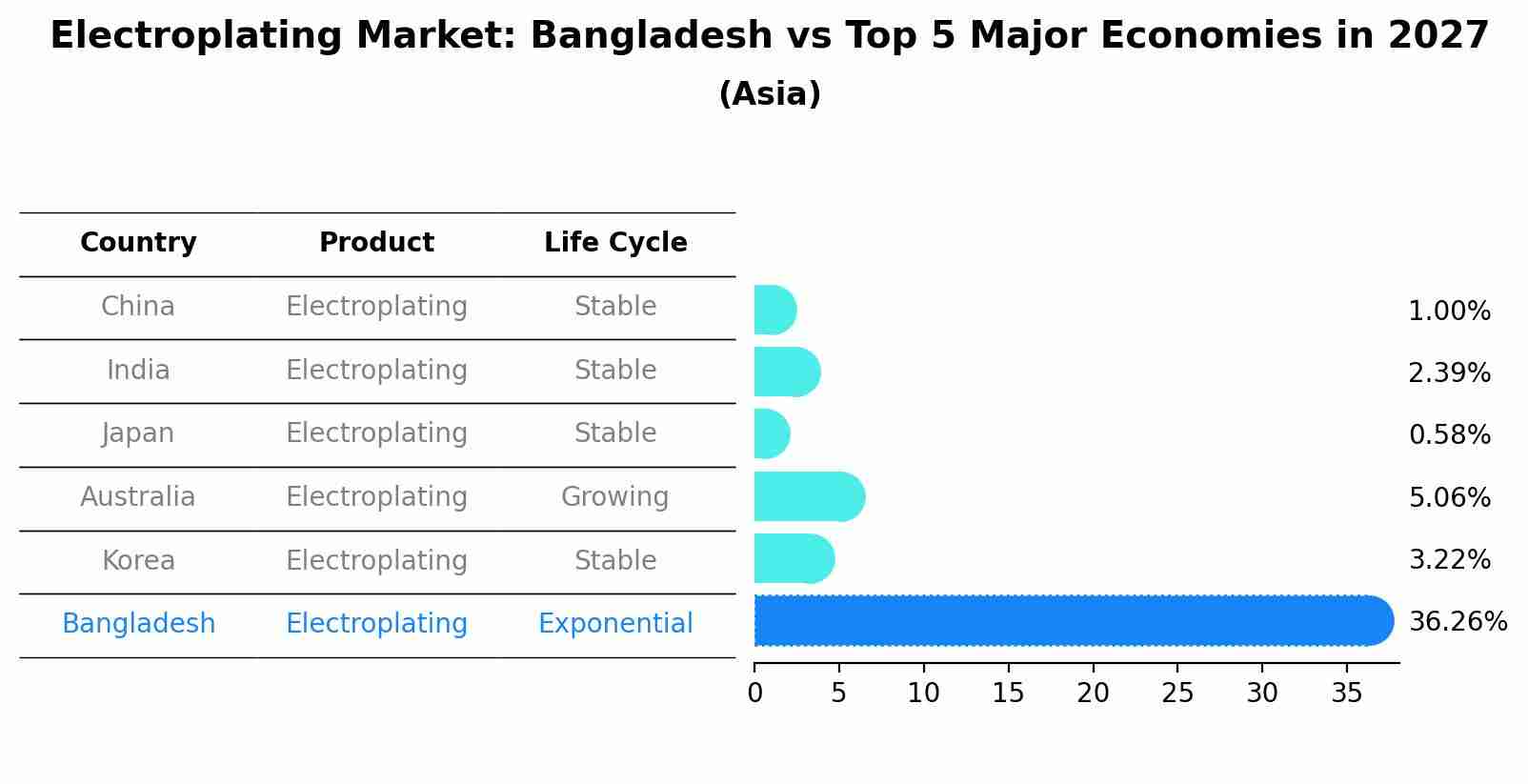Bangladesh Electroplating Market (2025-2031) Outlook | Revenue, Size, Share, Industry, Analysis, Value, Forecast, Trends, Companies, Growth
| Product Code: ETC104631 | Publication Date: Jun 2021 | Updated Date: Jun 2025 | Product Type: Report | |
| Publisher: 6Wresearch | Author: Shubham Padhi | No. of Pages: 70 | No. of Figures: 35 | No. of Tables: 5 |
Bangladesh Electroplating Market Size Growth Rate
The Bangladesh Electroplating Market could see a tapering of growth rates over 2025 to 2029. Although the growth rate starts strong at 49.40% in 2025, it steadily loses momentum, ending at 8.69% by 2029.

Electroplating Market: Bangladesh vs Top 5 Major Economies in 2027 (Asia)
The Electroplating market in Bangladesh is projected to grow at a exponential growth rate of 36.26% by 2027, within the Asia region led by China, along with other countries like India, Japan, Australia and South Korea, collectively shaping a dynamic and evolving market environment driven by innovation and increasing adoption of emerging technologies.

Bangladesh Electroplating Market Overview
The Bangladesh Electroplating Market is witnessing steady growth driven by increasing industrial activities, particularly in the automotive, electronics, and consumer goods sectors. The market is characterized by a rising demand for high-quality surface finishing solutions to enhance the durability and aesthetics of products. Key players in the market are focusing on technological advancements to offer eco-friendly and cost-effective electroplating solutions. Government initiatives to promote manufacturing activities and attract foreign investments are further boosting the market growth. Challenges such as environmental regulations and waste management issues are also influencing market dynamics. Overall, the Bangladesh Electroplating Market is poised for continued expansion, driven by growing industrialization and the need for superior surface treatment solutions across various industries.
Bangladesh Electroplating Market Trends
The Bangladesh Electroplating Market is witnessing several key trends. One prominent trend is the increasing adoption of eco-friendly and sustainable electroplating processes to comply with environmental regulations and reduce the industry`s carbon footprint. Another trend is the growing demand for advanced technologies and automation in electroplating processes to enhance efficiency and productivity. Additionally, there is a rising focus on developing innovative coatings and finishes to meet the evolving needs of industries such as automotive, electronics, and aerospace. Furthermore, the market is experiencing a shift towards the use of alternative materials and substrates to address concerns related to the toxicity of traditional plating materials. Overall, these trends are shaping the Bangladesh Electroplating Market towards a more sustainable and technologically advanced future.
Bangladesh Electroplating Market Challenges
The Bangladesh Electroplating Market faces several challenges, including strict environmental regulations governing the disposal of hazardous waste generated during the electroplating process. Compliance with these regulations can be costly for businesses, impacting their profitability. Additionally, the availability of skilled workers trained in electroplating techniques is limited, leading to a shortage of qualified personnel in the industry. Moreover, fluctuations in the prices of raw materials used in the electroplating process, such as metals and chemicals, can also pose challenges for businesses in managing their production costs and pricing strategies. Overall, addressing these challenges requires industry players to invest in sustainable practices, workforce development, and effective cost management strategies to remain competitive in the market.
Bangladesh Electroplating Market Investment Opportunities
The Bangladesh Electroplating Market offers several investment opportunities for both local and foreign investors. With the country`s growing industrial sector and increasing demand for electroplated products in various industries such as automotive, electronics, and manufacturing, there is a significant potential for growth in this market. Investing in modernizing existing electroplating facilities, introducing environmentally friendly plating technologies, and establishing new electroplating plants can be lucrative ventures. Additionally, providing support services such as waste treatment and recycling solutions for the electroplating industry can also be a promising investment opportunity. Overall, the Bangladesh Electroplating Market presents a favorable environment for investors looking to capitalize on the country`s industrial growth and increasing demand for electroplated products.
Bangladesh Electroplating Market Government Policy
The Bangladesh government has implemented several policies related to the electroplating market to regulate the industry and promote sustainable practices. The Department of Environment (DoE) enforces environmental regulations to control pollution from electroplating operations, requiring businesses to obtain Environmental Clearance Certificates. The Bangladesh Standards and Testing Institution (BSTI) sets standards for electroplating chemicals to ensure product quality and safety. Additionally, the government provides incentives such as tax breaks and subsidies for businesses adopting eco-friendly technologies and improving their environmental performance. These policies aim to mitigate the environmental impact of electroplating activities, promote compliance with safety standards, and encourage the industry to transition towards more sustainable practices in line with global trends.
Bangladesh Electroplating Market Future Outlook
The Bangladesh electroplating market is expected to witness steady growth in the coming years due to increasing industrialization and demand for electroplated products across various sectors such as automotive, electronics, and construction. The market is likely to benefit from advancements in technology, which will improve the efficiency and quality of electroplating processes. Additionally, growing awareness about the importance of corrosion protection and aesthetic enhancement in products will drive the demand for electroplating services. However, challenges related to environmental regulations and sustainability practices may require market players to invest in eco-friendly solutions and adhere to stringent guidelines. Overall, the Bangladesh electroplating market is poised for growth, supported by rising industrial activities and evolving consumer preferences.
Key Highlights of the Report:
- Bangladesh Electroplating Market Outlook
- Market Size of Bangladesh Electroplating Market, 2021
- Forecast of Bangladesh Electroplating Market, 2031
- Historical Data and Forecast of Bangladesh Electroplating Revenues & Volume for the Period 2021 - 2031
- Bangladesh Electroplating Market Trend Evolution
- Bangladesh Electroplating Market Drivers and Challenges
- Bangladesh Electroplating Price Trends
- Bangladesh Electroplating Porter's Five Forces
- Bangladesh Electroplating Industry Life Cycle
- Historical Data and Forecast of Bangladesh Electroplating Market Revenues & Volume By Metal for the Period 2021 - 2031
- Historical Data and Forecast of Bangladesh Electroplating Market Revenues & Volume By Gold for the Period 2021 - 2031
- Historical Data and Forecast of Bangladesh Electroplating Market Revenues & Volume By Copper for the Period 2021 - 2031
- Historical Data and Forecast of Bangladesh Electroplating Market Revenues & Volume By Nickel for the Period 2021 - 2031
- Historical Data and Forecast of Bangladesh Electroplating Market Revenues & Volume By Others for the Period 2021 - 2031
- Historical Data and Forecast of Bangladesh Electroplating Market Revenues & Volume By Type for the Period 2021 - 2031
- Historical Data and Forecast of Bangladesh Electroplating Market Revenues & Volume By Barrel Plating for the Period 2021 - 2031
- Historical Data and Forecast of Bangladesh Electroplating Market Revenues & Volume By Rack Plating for the Period 2021 - 2031
- Historical Data and Forecast of Bangladesh Electroplating Market Revenues & Volume By Continuous Plating for the Period 2021 - 2031
- Historical Data and Forecast of Bangladesh Electroplating Market Revenues & Volume By Line Plating for the Period 2021 - 2031
- Historical Data and Forecast of Bangladesh Electroplating Market Revenues & Volume By End-User Industry for the Period 2021 - 2031
- Historical Data and Forecast of Bangladesh Electroplating Market Revenues & Volume By Automotive for the Period 2021 - 2031
- Historical Data and Forecast of Bangladesh Electroplating Market Revenues & Volume By Electrical and Electronics for the Period 2021 - 2031
- Historical Data and Forecast of Bangladesh Electroplating Market Revenues & Volume By Aerospace and Defense for the Period 2021 - 2031
- Historical Data and Forecast of Bangladesh Electroplating Market Revenues & Volume By Medical for the Period 2021 - 2031
- Historical Data and Forecast of Bangladesh Electroplating Market Revenues & Volume By Others for the Period 2021 - 2031
- Bangladesh Electroplating Import Export Trade Statistics
- Market Opportunity Assessment By Metal
- Market Opportunity Assessment By Type
- Market Opportunity Assessment By End-User Industry
- Bangladesh Electroplating Top Companies Market Share
- Bangladesh Electroplating Competitive Benchmarking By Technical and Operational Parameters
- Bangladesh Electroplating Company Profiles
- Bangladesh Electroplating Key Strategic Recommendations
Frequently Asked Questions About the Market Study (FAQs):
- Single User License$ 1,995
- Department License$ 2,400
- Site License$ 3,120
- Global License$ 3,795
Search
Related Reports
- ASEAN Bearings Market (2025-2031) | Strategy, Consumer Insights, Analysis, Investment Trends, Opportunities, Growth, Size, Share, Industry, Revenue, Segments, Value, Segmentation, Supply, Forecast, Restraints, Outlook, Competition, Drivers, Trends, Demand, Pricing Analysis, Competitive, Strategic Insights, Companies, Challenges
- Europe Flooring Market (2025-2031) | Outlook, Share, Industry, Trends, Forecast, Companies, Revenue, Size, Analysis, Growth & Value
- Saudi Arabia Manlift Market (2025-2031) | Outlook, Size, Growth, Trends, Companies, Industry, Revenue, Value, Share, Forecast & Analysis
- Uganda Excavator, Crane, and Wheel Loaders Market (2025-2031) | Strategy, Consumer Insights, Analysis, Investment Trends, Opportunities, Growth, Size, Share, Industry, Revenue, Segments, Value, Segmentation, Supply, Forecast, Restraints, Outlook, Competition, Drivers, Trends, Demand, Pricing Analysis, Competitive, Strategic Insights, Companies, Challenges
- Rwanda Excavator, Crane, and Wheel Loaders Market (2025-2031) | Strategy, Consumer Insights, Analysis, Investment Trends, Opportunities, Growth, Size, Share, Industry, Revenue, Segments, Value, Segmentation, Supply, Forecast, Restraints, Outlook, Competition, Drivers, Trends, Demand, Pricing Analysis, Competitive, Strategic Insights, Companies, Challenges
- Kenya Excavator, Crane, and Wheel Loaders Market (2025-2031) | Strategy, Consumer Insights, Analysis, Investment Trends, Opportunities, Growth, Size, Share, Industry, Revenue, Segments, Value, Segmentation, Supply, Forecast, Restraints, Outlook, Competition, Drivers, Trends, Demand, Pricing Analysis, Competitive, Strategic Insights, Companies, Challenges
- Angola Excavator, Crane, and Wheel Loaders Market (2025-2031) | Strategy, Consumer Insights, Analysis, Investment Trends, Opportunities, Growth, Size, Share, Industry, Revenue, Segments, Value, Segmentation, Supply, Forecast, Restraints, Outlook, Competition, Drivers, Trends, Demand, Pricing Analysis, Competitive, Strategic Insights, Companies, Challenges
- Israel Intelligent Transport System Market (2025-2031) | Strategy, Consumer Insights, Analysis, Investment Trends, Opportunities, Growth, Size, Share, Industry, Revenue, Segments, Value, Segmentation, Supply, Forecast, Restraints, Outlook, Competition, Drivers, Trends, Demand, Pricing Analysis, Competitive, Strategic Insights, Companies, Challenges
- Uganda Precast and Aggregate Market (2025-2031) | Strategy, Consumer Insights, Analysis, Investment Trends, Opportunities, Growth, Size, Share, Industry, Revenue, Segments, Value, Segmentation, Supply, Forecast, Restraints, Outlook, Competition, Drivers, Trends, Demand, Pricing Analysis, Competitive, Strategic Insights, Companies, Challenges
- Australia IT Asset Disposal Market (2025-2031) | Strategy, Consumer Insights, Analysis, Investment Trends, Opportunities, Growth, Size, Share, Industry, Revenue, Segments, Value, Segmentation, Supply, Forecast, Restraints, Outlook, Competition, Drivers, Trends, Demand, Pricing Analysis, Competitive, Strategic Insights, Companies, Challenges
Industry Events and Analyst Meet
Our Clients
Whitepaper
- Middle East & Africa Commercial Security Market Click here to view more.
- Middle East & Africa Fire Safety Systems & Equipment Market Click here to view more.
- GCC Drone Market Click here to view more.
- Middle East Lighting Fixture Market Click here to view more.
- GCC Physical & Perimeter Security Market Click here to view more.
6WResearch In News
- Doha a strategic location for EV manufacturing hub: IPA Qatar
- Demand for luxury TVs surging in the GCC, says Samsung
- Empowering Growth: The Thriving Journey of Bangladesh’s Cable Industry
- Demand for luxury TVs surging in the GCC, says Samsung
- Video call with a traditional healer? Once unthinkable, it’s now common in South Africa
- Intelligent Buildings To Smooth GCC’s Path To Net Zero













